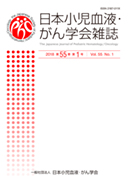Volume 57, Issue 2
Displaying 1-21 of 21 articles from this issue
- |<
- <
- 1
- >
- >|
The 61th Annual Meeting of the Japanese Society of Pediatric Hematology / Oncology
-
2020Volume 57Issue 2 Pages 61-70
Published: 2020
Released on J-STAGE: September 03, 2020
Download PDF (12754K) -
2020Volume 57Issue 2 Pages 71-79
Published: 2020
Released on J-STAGE: September 03, 2020
Download PDF (6008K) -
2020Volume 57Issue 2 Pages 80-84
Published: 2020
Released on J-STAGE: September 03, 2020
Download PDF (1131K)
-
2020Volume 57Issue 2 Pages 85-91
Published: 2020
Released on J-STAGE: September 03, 2020
Download PDF (964K)
-
2020Volume 57Issue 2 Pages 92-95
Published: 2020
Released on J-STAGE: September 03, 2020
Download PDF (1115K) -
2020Volume 57Issue 2 Pages 96-100
Published: 2020
Released on J-STAGE: September 03, 2020
Download PDF (909K)
-
2020Volume 57Issue 2 Pages 101-110
Published: 2020
Released on J-STAGE: September 03, 2020
Download PDF (1091K)
-
2020Volume 57Issue 2 Pages 111-115
Published: 2020
Released on J-STAGE: September 03, 2020
Download PDF (5298K) -
2020Volume 57Issue 2 Pages 116-120
Published: 2020
Released on J-STAGE: September 03, 2020
Download PDF (3228K)
-
2020Volume 57Issue 2 Pages 121-125
Published: 2020
Released on J-STAGE: September 03, 2020
Download PDF (3777K)
Original Article
-
2020Volume 57Issue 2 Pages 126-131
Published: 2020
Released on J-STAGE: September 03, 2020
Download PDF (987K) -
2020Volume 57Issue 2 Pages 132-141
Published: 2020
Released on J-STAGE: September 03, 2020
Download PDF (926K) -
2020Volume 57Issue 2 Pages 142-149
Published: 2020
Released on J-STAGE: September 03, 2020
Download PDF (1463K) -
2020Volume 57Issue 2 Pages 150-156
Published: 2020
Released on J-STAGE: September 03, 2020
Download PDF (879K)
Case Report
-
2020Volume 57Issue 2 Pages 157-161
Published: 2020
Released on J-STAGE: September 03, 2020
Download PDF (2481K) -
2020Volume 57Issue 2 Pages 162-167
Published: 2020
Released on J-STAGE: September 03, 2020
Download PDF (2484K) -
2020Volume 57Issue 2 Pages 168-172
Published: 2020
Released on J-STAGE: September 03, 2020
Download PDF (5373K) -
2020Volume 57Issue 2 Pages 173-177
Published: 2020
Released on J-STAGE: September 03, 2020
Download PDF (882K)
Report of Committee
-
2020Volume 57Issue 2 Pages 178-184
Published: 2020
Released on J-STAGE: September 03, 2020
Download PDF (1320K)
Report
-
2020Volume 57Issue 2 Pages 185-187
Published: 2020
Released on J-STAGE: September 03, 2020
Download PDF (750K) -
2020Volume 57Issue 2 Pages 188-191
Published: 2020
Released on J-STAGE: September 03, 2020
Download PDF (865K)
- |<
- <
- 1
- >
- >|
